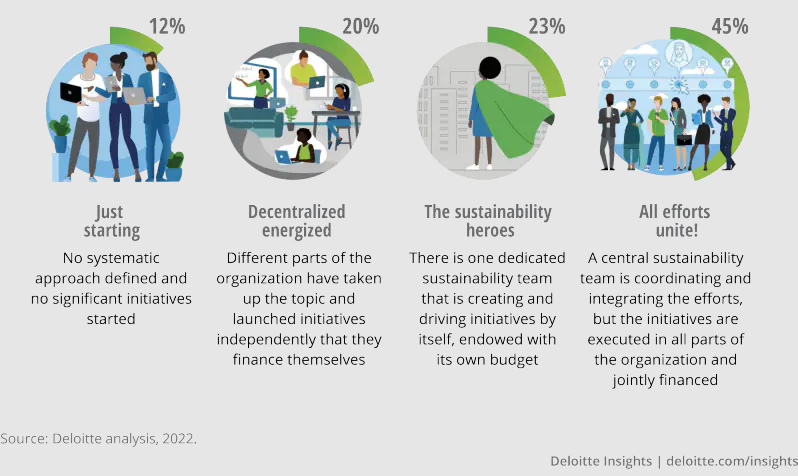Get the newest insights
Let us know your interests and get the most relevant reports, articles and events delivered straight to your inbox!
Sign up here
Understand what makes the sustainability transformation different from previous large-scale business transformations – and what executives need to consider making their transformation successful.

Integrate your sustainability efforts into your core strategy and transformation agenda.
Get the transformation fundamentals right.
Invest in your strategic foresight and ecosystem cocreation capabilities.
In recent years, research has focused on separating fact from fiction on transformative sustainability to help executives navigate the risks and exploit the opportunities. Most publications have focused on the WHY and the WHAT of sustainability, but the focus of this article is on the HOW.
The WHY: Taking decisive action towards sustainability can generate significant environmental benefits, and it will have positive financial effects in addition. A meta-study on the relationship between environmental, social and governance (ESG) and financial performance shows that progress on ESG is positively correlated with financial performance. In addition, a study from Deloitte estimated that decarbonisation carried out by the middle of this century could add €730 billion to Europe’s economy by 2070.
The WHAT: Different ESG issues are important for companies in different sectors, depending on the nature of their business. In the energy section, reducing carbon emissions is the most relevant. In health care, the focus is on product safety and quality. Taking an investor perspective can be a great way for executive teams to identify the ESG issues that hold the greatest risk to their business – or the biggest upside potential as levers for growth and differentiation (see MSCI ESG materiality map) if they are addressed.
Based on our analysis, we have identified four keys to success:
The first key
Don’t greenwash, but integrate your sustainability efforts into your core strategy and transformation agenda
Almost as old as the debate about sustainability is the discussion of greenwashing. Greenwashing refers to companies’ practices relating to the contribution of their products and operations to their ESG objectives, and especially decarbonisation. Greenwashing represents the opposite of profound integration of sustainability in the core strategy and must be avoided.
Instead of running a set of loosely connected initiatives labeled “sustainability transformation”, companies need to redefine where they will play and how they will win while meeting their sustainability expectations and ambitions.
The degree to which business models are impacted by the various ESG issues and resulting transformation needs of their business and operating model varies between sectors. This drives the risk and opportunity landscape of the company and thus their transformation approach.
The second key
Get your transformation fundamentals right
Moving sustainability from the edge to the core also enables companies to leverage their current capabilities to innovate, transform and execute and harness their existing transformation capabilities. Our survey shows that sustainability leaders succeed by harvesting the business transformation excellence they already have.
The third key
Strengthen your strategic foresight, ecosystem cocreation and strategy execution
From a managerial perspective many aspects of sustainable business transformation are the same as for prior transformations. But some distinctive differences are required to be successful in this new era.
Central to the sustainability transformation challenge is coping with, for example, the increase in external influences, including supply chain complexity, energy cost, employee and societal expectations. These challenges do not evolve in a linear, unrelated way. Network effects between them drive the need for unprecedented agility and speed.
Sustainable business transformation is not only special due to its complexity, but also because time is running out for humanity to tackle the climate crisis. Companies need to act now to have a chance of attaining their climate goals by 2050. However, acting now will require significant investments in unproven technologies today and these investments will have very long payback periods.
The fourth key
Choose your transformation mode based on your starting position
CSOs or equivalent heads of sustainability in organisation have different starting positions. In our Deloitte study, we distinguish between four different execution archetypes:

Forty-five percent of respondents choose the “All efforts unite” execution mode in which a central sustainability team coordinates and integrates the sustainability efforts across the organisation while the initiatives are executed in a decentralised way. This approach is very much in line with the deployment of a chief transformation officer and central Transformation Nerve Centre that we have seen is a key to success in previous large-scale business transformation programs.
It has become a consensus that a wide embedding of strategy and transformation into the organisation is required to make transformation a success.
Looking deeper into our survey data, a valuable insight emerges: one size does not fit all. Most leaders coming from an intermediate maturity level apply a different execution mode. They have chosen to drive their sustainable business transformation by nominating and empowering a strong central lead and team to drive sustainability across the organisation: “the sustainability heroes”.
Therefore, as an executive reflecting on how your organisation is currently pursuing its sustainable business transformation, you should start by honestly assessing your current strategic and transformation maturity. Then, carefully choose the execution mode that is the best fit and invest in a focused way in those transformation capabilities that move the needle.
Deloitte have interviewed more than 250 executives across all sectors to distil what makes business sustainability strategies so particular and what sets sustainability leaders apart from their peers.
Want more insights? You can explore the full article here.
Let us know your interests and get the most relevant reports, articles and events delivered straight to your inbox!
Sign up here